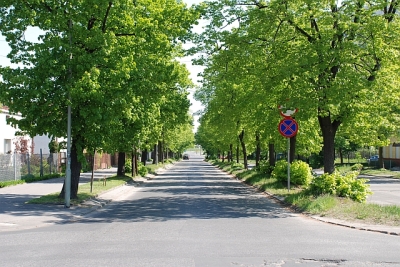The trams in the ghetto run along Zgierska and Limanowskiego streets. Only Aryans were allowed to travel the city by tram. From the widows they could see the people in the confined district. The Jews were forbidden to walk the road, although the houses and pavements belonged to the ghetto. The roads were separated by fences and wire entanglements; it was risky even to approach them (see: The Bridges of the Ghetto). For almost two years trams were a symbol of the world inaccessible to the ghetto inmates.
It changed in September 1941. First trams appeared in the ghetto streets. They transported food, fuel and raw materials from the Radegast station to various departments, and the goods produced in the ghetto back to the station.
 For this purpose tram lines were built along Brzezinska (today Wojska Polskiego), Marysinska and Jagiellonska (today Kolinskiego) streets. Side tracks were built to the most important departments, including the tailoring department at Jakuba Street, or the vegetable market at 1/3 Lagiewnicka Street. The public transportation started in June 1942; the trams transported people to work in Marysin. The Chronicle of the t6dt Ghetto recorded 159,000 tickets sold between June 1 and July 15. The trams transported daily over 3,000 people.
For this purpose tram lines were built along Brzezinska (today Wojska Polskiego), Marysinska and Jagiellonska (today Kolinskiego) streets. Side tracks were built to the most important departments, including the tailoring department at Jakuba Street, or the vegetable market at 1/3 Lagiewnicka Street. The public transportation started in June 1942; the trams transported people to work in Marysin. The Chronicle of the t6dt Ghetto recorded 159,000 tickets sold between June 1 and July 15. The trams transported daily over 3,000 people.
At the end of 1942, the authorities of Litzmannstadt opened another transit tram line running through the ghetto, for Germans and Poles only. Unlike Zgierska Street, the road was not separated from the ghetto, but the doors were sealed before entering the ghetto area and opened only outside of it. A German policeman stood guard so that no one could get in or off in the ghetto. The rails ran down Franciszkanska and Brzezinska streets towards the Doly district.
As a result of long efforts made by the Eldest of the Jews, in September the ghetto was equipped with tram transportation. The meagre fleet, including two old type motor cars and a few passenger cars, was handed over to the ghetto on September 13. Engineer Dawidowicz was appointed the manager of the tram transportation service. The metal works factory assigned several candidates for drivers. The [German] authorities delegated an instructor to conduct driving classes for one week. The trams will connect Marysin and Balucki Rynek. The tracks will be laid from Brzezinska Street to Marysin. Unused rails from other streets will be used for this purpose. Efforts are also made to obtain rails from the outside. The first departure of trams to the ghetto streets for driving classes caused a real sensation.
The Chronicle of the Lodz Ghetto, September 1941, Vol. 1, p. 250.
The Tram Transportation department commenced the construction of a sidetrack between Lagiewnicka Street and the coal depot. A few days ago the sidetrack to the vegetable market at Lagiewnicka Street was finished. The passenger transportation, which would be a great convenience for the working ghetto inhabitants, is also planned.
The Chronicle of the Lodz Ghetto, May 20-21, 1942, Vol. 1, p. 580.
The drive from Balucki Rynek to the last stop at Marysin (near the former cinema) lasts 20 minutes. The passenger transportation between 8 a.m. and 3 p.m. is irregular because of the intensity of the goods transport. From 5 to 7:15 p.m. the trams leave every 30 minutes for the convenience of the workers employed at Marysin. The Radegast Station workers, the cemetery service, the workers employed in the wood depot at Marysin, the woodwork factory and the shoe factory at 100 Marysinska Street are given priority to buy the tickets.
The Chronicle of the Lodz Ghetto, June 5, 1942, Vol. 2, p. 33.

 Home
Home
